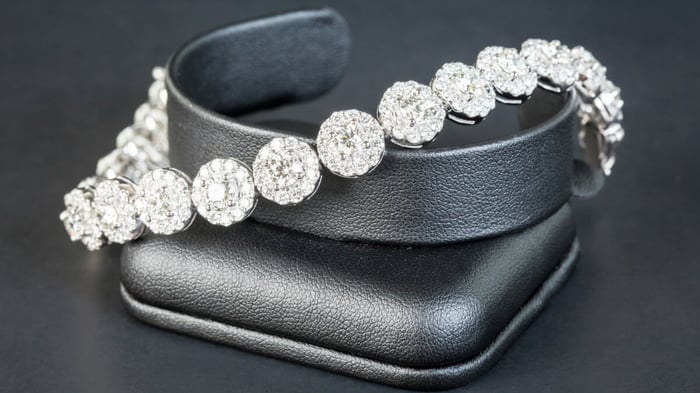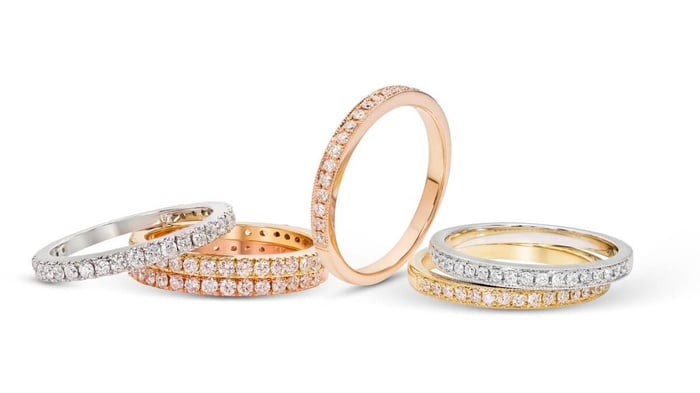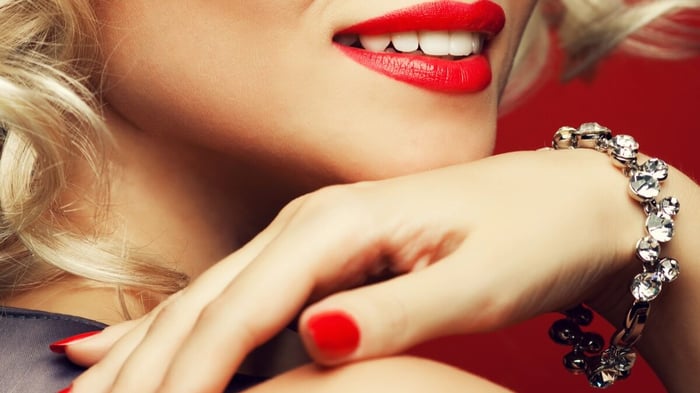The History Of Bracelets Tells Us Why They Are Popular Today!
Bracelets are among the most popular pieces of jewellery worn by men and women. This has been true for thousands of years. This article takes a brief look at the long history of bracelets and how they have changed and developed over the centuries.
The First Bracelets
The first bracelets dating back to approximately 2500 BC were found by archaeologists. The first bracelets that were known were worn by people from southern Mesopotamia. Sumerian women were made into showcases of their husband's prosperity by wearing jewellery, not just bracelets but anklets, necklaces, earrings, and finger rings. Bracelets were found in the tombs of people from the city of Ur. It was customary for royalty to have their jewellery and servants with them in the afterlife.
Bracelets In Ancient Egypt
Bracelets were important in Ancient Egypt. Charm bracelets were first used during the Pharaonic period. Charms date back to the Neolithic age. Men would carry wood or stone about their bodies to ward off enemies. These charms were powerful protectors against harmful events. It wasn't until Ancient Egypt that these charms were incorporated into elaborate jewellery such as bracelets and necklaces, which were seen as a sign of how wealthy the person had been. The Gods of this person's afterlife would be able to see these jewellery pieces and understand the person’s correct status.
Brazalete de tenis con diamantes y rubíes de 2,35 ct en oro amarillo de 18 k

€2.501,95
Este deslumbrante brazalete de rubíes y diamantes es un regalo elegante o un regalo decadente solo para usted. El rojo intenso del rubí crea un sorprendente contraste con los brillantes diamantes de calidad G/SI de origen ético. Montado en oro… read more
Ancient Greek Bracelets
In Grecian times bracelets became popular among men. Soldiers wore leather bands on their forearms to protect against opponents’ weapons. Often decorated with silver and gold, sometimes with gemstones. They were known as ‘Bracels,’ from the Latin Brachium, meaning, ‘arm.’ When women realised that these Bracels would look great on their arms, they started wearing more delicate versions, called little Bracels...or ‘Bracel-ets.’
After the destruction of Pompeii by the eruption of the volcano Vesuvius in 79 AD, bracelets were hidden in the ruins. They were not uncovered until the 19th century by modern archaeologists.
Roman Bracelet Fashions
Many of the design ideas seen on Roman bracelets were also found on earrings and necklaces from the same period. Ball earrings were very popular, and they looked great with a ball bracelet.
During the Roman era, engraved bangles and snake bracelets were particularly fashionable. Bracelets consisting of twisted metal coils with lion head ends, as well as two-part bracelets with a pair of lion heads, were popular.
The Heracles knot bracelet is said to be from the Roman era. The Romans were incredibly inventive when it came to jewellery creation. However, they continued to use Greek themes. Palmettos, escaping hounds, and acanthus leaves, all of Greek origin, were frequently featured in Roman jewellery.
In Roman bracelets, stones and glass were frequently utilised. Gemstones were commonly found in people’s eyes or animals depicted on jewellery. Open bands intertwined with pearls were carved to imitate a row of ivy. Many of the leaf and berry bracelets had a lot of beautiful glass set into them. Bracelets stacked with bezel set emeralds were prevalent on the wealthiest women.
Bracelets In The Middle Ages and Onward
The history of the bracelet can be traced through the Middle Ages and the 18th century's Baroque period. During the Georgian period, bracelets were fashionable. There were a lot of gold bracelets with pearl edging.
After the 1820s, bracelets and other jewellery were liberally set with coral. Bracelets such as silk ribbon bracelets and broad ribbon gold mesh bracelets were very stylish. Geometric designs are used to make bracelets. The use of gold was common.
Bracelets In The Victorian Era
During the Victorian era, women's clothes changed. The earrings became longer and hung. These earrings stretched the wearer's earlobes permanently. Bracelets were frequently worn in pairs.
The Victorian era preferred jewellery that represented emotion. Bracelets had charms with photos or hair of a loved one. Much Victorian jewellery was filled with mystic notions. Acrostic bracelets with each gemstone's initial letter spelling out a term of friendship were very popular. For example, a bracelet containing Lapis would spell Love.
20th Century Bracelets
Throughout the early 20th century, fashion changed dramatically, and jewellery was a huge part of fashion. Bracelets of the time were often decorated with snakes and lizards. Many of the most popular animals included birds, dragons, butterflies, bees, and peacocks.
A famous symbol was the scarab beetle, a symbol dating back to ancient Egypt. This reflected an interest in the period brought about by the discovery of King Tutankhamun’s tomb in the early years of the century.
This was a powerfully symbolic time, with a solid connection to nature. If there were no creatures on the jewellery, there were flower blooms or flower buds.
From 1910 to 1939, women's styles included sleeveless or short sleeve dresses. Flexible bracelets and bangles for the upper arm were the outcomes. Gemstones and diamonds were frequently used to embellish these arm bracelets.
From 1940 through 1949, the designs of Van Cleef & Arpels, a French firm, had a significant effect on American designers. Bracelets with a ribbon of hexagon lines running through them and exquisite jewels in the centre, attached with strong clasps, were trendy.
Rub Over Diamond Tennis Brazalete de 2,00 ct G/SI en oro amarillo de 9 k
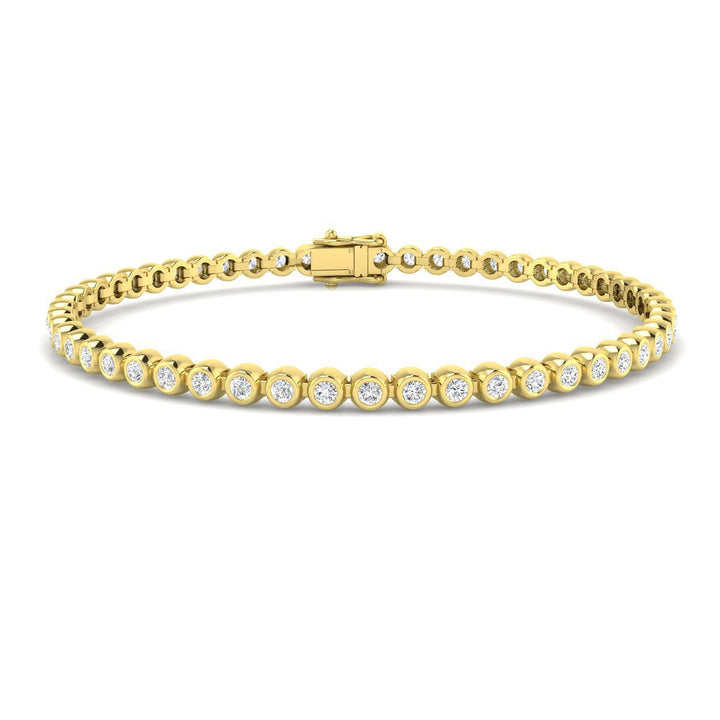
€2.145,95
Para un look más refinado, elija esta pulsera de diamantes como accesorio perfecto. Confeccionado con un look clásico para múltiples ocasiones, es una hermosa pieza de joyería que se puede usar con cualquier atuendo. Este oro amarillo especialmente seleccionado cuenta… read more
From 1950 to 1960, gold bracelets and necklaces had plainer lines. Bracelets made of gold mesh or twisted wire were popular.
Between 1960 and 1970, bracelets grew more flexible and were frequently set with diamonds Bangles, on the other hand, were stiffer and were often seen with haphazard diamond placements.
During the 1970s, bracelets were flexible and commonly set with small baguettes. Bracelets that were delicate and elegant were popular.
Since the 1980s, bracelet trends have been variable and varied. Bracelet styles have evolved into more of a personal style statement than a fad. Gold, like jewels, has long been popular. On the other hand, Sterling silver has grown in popularity and recognition because of its adaptability and wearability at a lower cost than gold or platinum. Titanium bracelets have also experienced a surge in popularity in recent years.
Bracelets Today
Today's fashion statement for ladies is all about her! What she enjoys and feels comfortable in. As a result, your bracelet collection can be whatever you choose. Wear a delicate gem-set gold bracelet or a slew of clunky bangles. In recent years, the latter have become increasingly fashionable.
Over the millennia, bracelets have been made using a multitude of materials such as iron, leather, copper, gold, beads, bone and teeth, silver and gemstones.
As we can see, the bracelet has been popular since the start of civilisation. Styles have varied according to contemporary dress styles. In cultures where the people wore sleeveless or short-sleeved clothing, such as during the Roman and ancient Greek eras, the wearing of bracelets on both the upper and lower arm was popular with men and women. People still love to wear upper arm bracelets today, with modern fashionable clothing’s skimpy styles lending themselves to wearing more jewellery.
Today, men and women wear bracelets in various materials such as precious metals like silver, gold, and platinum. Modern plastics and acrylics are now used to create fashionable, unusual bracelets. In higher-end jewellery, metals like titanium and zirconium have become popular due to their hard-wearing, lightweight, and hypoallergenic properties. No matter your tastes and budget, there is a vast choice of bracelets and bangles to suit you.
Your fashion statement is about who you are, so feel free to be you!
Brazalete de diamantes en engarce de tensión Diamante G/SI de 0,75 quilates en oro amarillo de 18 k
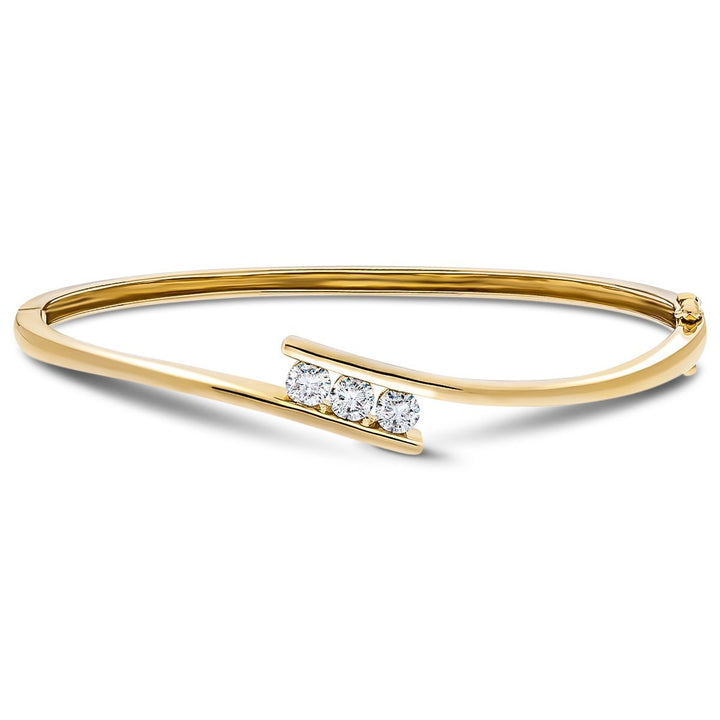
€3.766,95
Esta pieza elegante y con estilo está hecha de hermoso oro amarillo que es suave y pulido al tacto. Tallado con un hermoso diamante engastado en tensión, es una adición hermosa y moderna a cualquier colección de joyas. Esta elegante… read more
All Diamond’s Bracelets And Bangles
Now that you know more about the history of bracelets it is time to look at how the past influences present-day designs!
All Diamond’s collection of fine diamond bracelets and bangles, all designed and handcrafted in Britain, reflects both modern trends and older styles.
Please take a few minutes to browse our collections of beautiful diamond bracelets and bangles. We would love to be a part of making your own memories and history!
